How often is too often? Frequency can become a crucial factor when it comes to email marketing. It’s not so easy to find the right balance between not being annoying and not being forgotten.
In this article, we’ll investigate a list of email frequency research papers and give you some tips on how to choose an optimal frequency for your own email campaigns.
The definition of email marketing frequency
First, what do we mean by “frequency?” You may mix up the email frequency with email timing. Let’s differentiate:
- email timing demonstrates what time of day or what day of the week you send emails;
- email frequency indicates how many times a day, a week, or a month you send emails.
There is no universal truth when it comes to defining email frequency as low or high as this fully depends on the brand and its audience.
On the one hand, one insurance company managed to improve its email revenue by 45% as well as other metrics by increasing the email marketing frequency. Previously, the company used to send only one email a year — right before it was time to renew the insurance of their clients. They decided to increase the email frequency for a part of their mailing list in order to improve the return on these customers. Meanwhile, their customers were asked to participate in the regular survey where they left feedback on monthly emails with promotions and useful content they got. The company constantly tested the results and in three months, they noticed that the number of clicks and quotes, as well as their revenue had grown significantly, which enabled the brand to roll out the strategy on their entire mailing list.
On the other hand, a retail store saw a huge drop in Average Daily Revenue (ADR) after increasing their email frequency. When the store started sending emails from three to four times a month, they noticed their ADR decrease from $696.5 to $475. As soon as they lowered the frequency to two emails a month, the number of orders had grown immediately again.
In fact, when it comes to email frequency, both undersending and oversending have their own strong and weak points.
|
High email campaign frequency |
Low email campaign frequency |
| Risks |
You may end up with users ignoring your messages or not having enough time to open and read all of them.
It may become challenging to come up with fresh and relevant content if you need to create it every other day. |
Your company name may be forgotten by subscribers and your emails may start being sent to spam.
Your sales may decrease as a result of users not receiving enough offers or simply forgetting about them. |
| Opportunities |
More emails equals more unique chances for users to purchase your products or at least interact with your brand. |
You will be able to avoid email fatigue, low activity numbers, and low sales.
Sending out fewer emails means you can invest more time, energy, and ideas into creating unique content and catchy design for each of them. |
To have a better overview of how often different companies prefer sending and subscribers getting emails, let’s go through statistics.
Email marketing frequency statistics
Curious data from DMA shows that email marketers believe they send on average 21 emails per week, while consumers feel like they receive an average of 44 emails per week from various brands. Considering the fact that an average user has 2,6 email addresses and is subscribed to emails from 12 brands, the feeling of being overwhelmed with emails may appear for two reasons: users are subscribed to too many brand emails that pile up in users’ mailboxes, and huge competition between brands in inboxes.
Actually, 29% of users who have stopped using their email address did it because they had signed up for too many emails. At the same time, 54% of users said that spam was the main reason for retiring an email address, and by spam, they might also mean emails from unknown senders, for example.
Why users stop using their personal email address
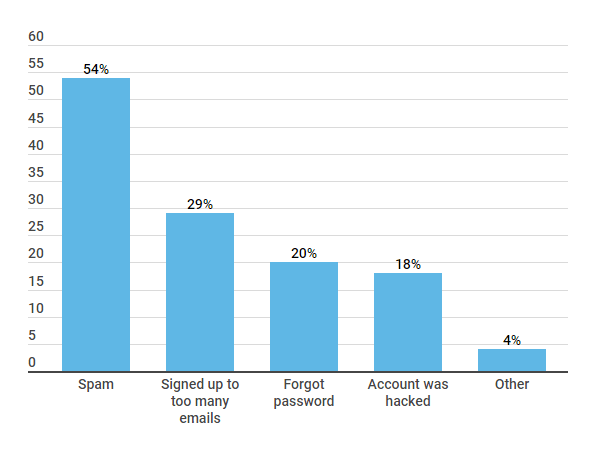 Source: DMA Consumer Email Tracker 2017
Source: DMA Consumer Email Tracker 2017
When we look at the reasons why users open emails from brands, we see that the most important factor is the brand name they can recognize. So, the more often a person sees your name in their inbox, the higher the chances are that they will remember you. However, on the other side of the coin — users may get annoyed and unsubscribe.
The most important factors influencing users’ choice to open an email
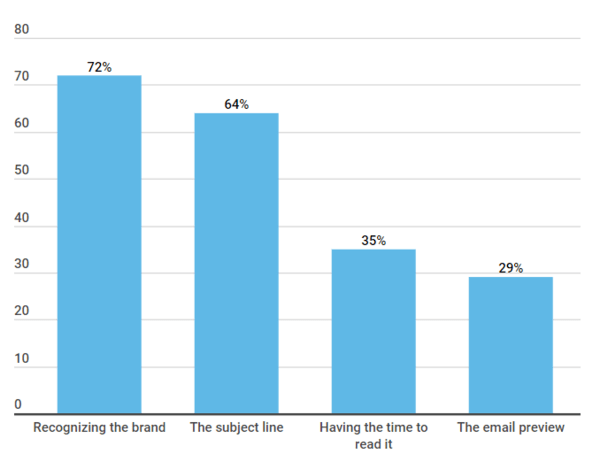 Source: DMA Consumer Email Tracker 2019
Source: DMA Consumer Email Tracker 2019
Often, the reasons that a user unsubscribes and the reasons an email is marked overlap. All sorts of confusion like sending irrelevant information, sending emails too frequently , or using an unrecognizable sender name may cause users to try to stop communicating with a brand.
Top reasons to mark emails as spam or unsubscribe
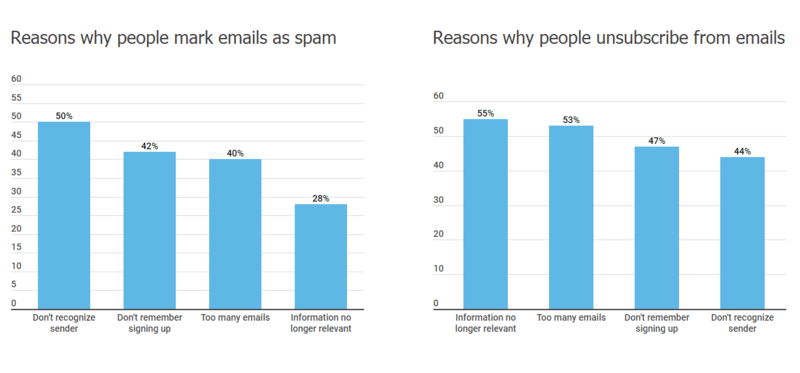 Source: DMA Consumer Email Tracker 2017
Source: DMA Consumer Email Tracker 2017
Talking about the effectiveness of high email marketing frequency, sometimes less is more. Stats from GetResponse show that brands that send out just one email per week have the highest open and click-through rates, compared to higher-frequency senders.
Number of emails sent per week
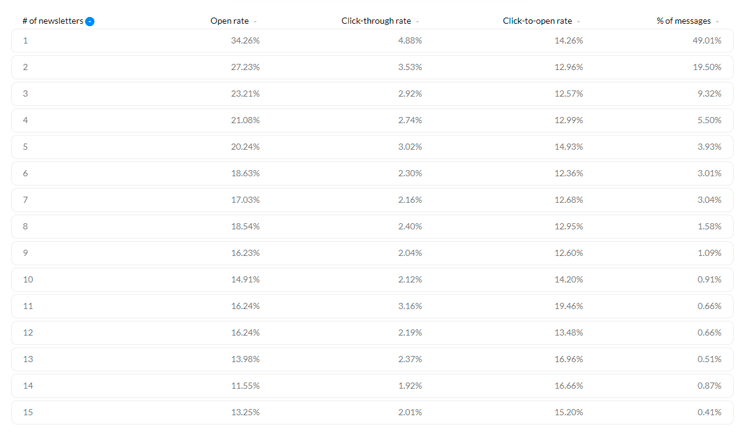 Source: GetResponse Email Marketing Benchmarks
Source: GetResponse Email Marketing Benchmarks
Other results were brought in by Return Path. In their research, they divide users into three categories:
- primary users who account for 83% of all opens;
- secondary users who account for 16% of all opens;
- dead users who account for 1% of all opens.
Here’s what Return Path did:
- increased the number of emails for primary users by one additional email per week;
- increased the number of emails for secondary users by one email biweekly.
The experiment resulted in a 40.1% increase in ROI. The ROI of primary users grew by 43.3% and ROI of secondary users improved by 33.3%.
At the same time, Return Path recommends that you should send no more than five emails per week to primary users.
Best practices for email marketing frequency
Even though it all depends on your particular situation, there are some best practices for email marketing frequency that will be helpful on your way to achieve the perfect balance.
After going through the email frequency statistics above, we’ve arrived at these three conclusions:
- Allow users to choose the email frequency they prefer.
- Provide high quality email content.
- Hold A/B tests and pay attention to your statistics.
Let’s take a closer look at each of them.
Offer users a choice
As mentioned above, on average, users are subscribed to 12 different brands, and it can become overwhelming even if each of them sends one email per day. That’s why every individual user should be able to decide for themselves how often they want to see you in their inbox.
Of the different personalization options, The FeedFeed allows users to decide whether they want to receive weekly, daily, or both types of emails.
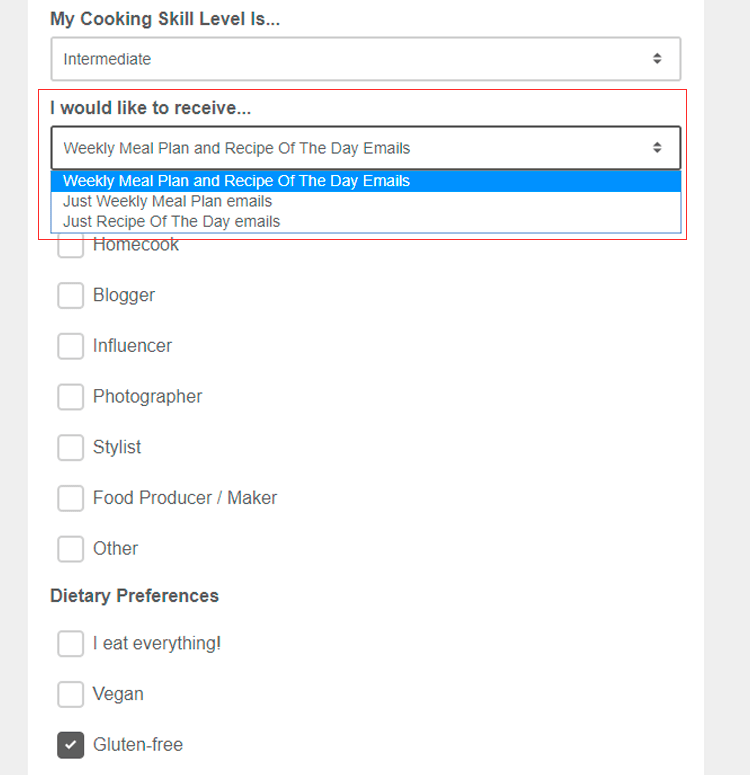 Email preferences on The FeedFeed website
Email preferences on The FeedFeed website
Prefer quality over quantity
As we’ve learned from the DMA Consumer Email Tracker in 2017, 55% of users opt out of a brand’s emails because the content becomes irrelevant to them.
You should do your best to provide your audience with what they actually want to receive. For example, most people subscribe to emails from brands to receive gifts or freebies. So, why not to include ones into your campaign?
Factors that persuade people to give their email addresses to a brand, shop, or website
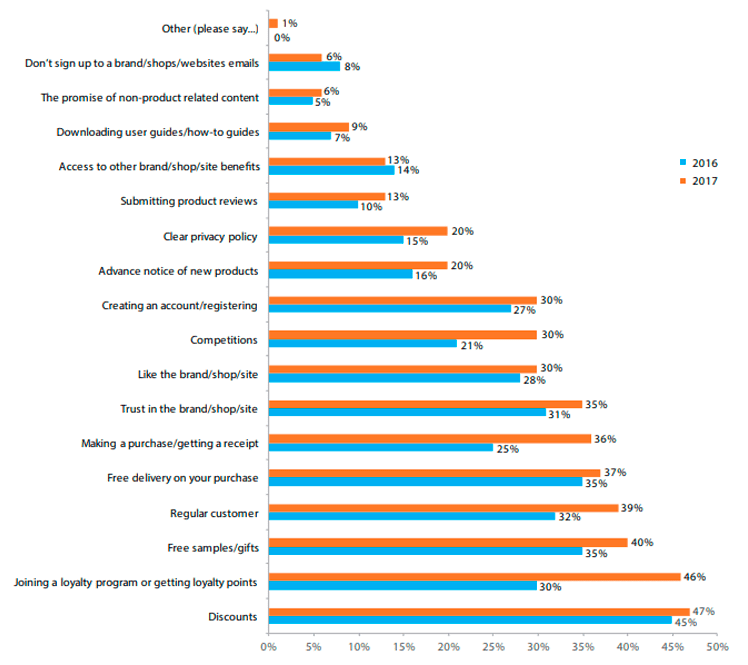 Source: DMA Consumer Email Tracker 2017
Source: DMA Consumer Email Tracker 2017
Combine informational and promotional emails to make the content interesting, educational, and valuable to the audience. If your emails are relevant, users will be more likely to open, read, and click without being annoyed by the email frequency.
To find out what your subscribers want to see in their inboxes, follow statistics on opens and clicks and ask subscribers for feedback to know exactly what they like.
The wrong way to deal with email marketing frequency is to blindly follow other companies. Your audience, your product, and your goals are unique, and that’s why you should keep holding A/B tests to be constantly improving.
You can try to divide your subscribers into groups based on their activity and test an updated email frequency on 20% of users from each group. The frequency option that brings in the most engagement should be adopted.
To lower your risks, you can rollout the new email frequency gradually, adding more and more users and holding tests over and over until you are sure in your choice.
All in all
When it comes to email, the best strategy is to always listen to the needs of your audience and do your best to meet their expectations.
To find your perfect balance in email marketing frequency, remember these three golden rules:
- Take care of your subscribers and allow them to choose how often they want to interact with your brand.
- Create relevant content and constantly ask for feedback to keep improving the quality of your emails.
- Test, adjust, and test again — that’s the right way to go.
Remember to use SendPulse, even our free plan has useful features like Automation 360, Facebook Messenger chatbots, a flexible drag and drop email editor, a user-friendly subscription form builder, and many others.